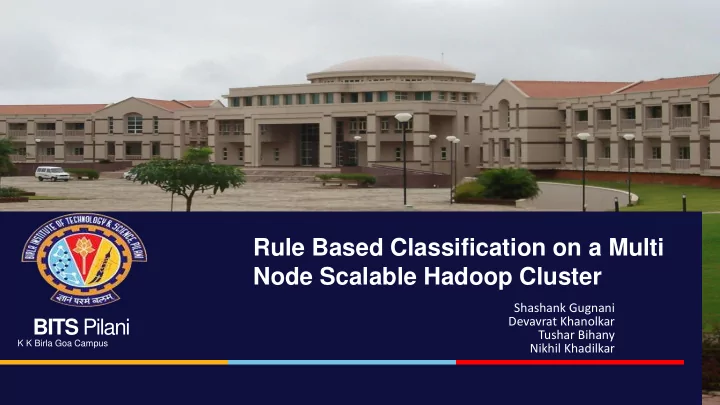

Rule Based Classification on a Multi Node Scalable Hadoop Cluster Shashank Gugnani Devavrat Khanolkar BITS Pilani Tushar Bihany K K Birla Goa Campus Nikhil Khadilkar
Data Hypergrowth Reuters-21578: about 10K docs (ModApte) Bekkerman et al, SIGIR 2001 RCV1: about 807K docs Bekkerman & Scholz, CIKM 2008 LinkedIn job title data: about 100M docs Bekkerman & Gavish, KDD 2011 Common Crawl Corpus: 5 Billion docs Common Crawl Foundation, 2014 9/29/2014 BITS Pilani, K K Birla Goa Campus
New Age of Data The world has gone mobile 5 billion cellphones produce daily data Social networks have gone online Twitter produces 200M tweets a day The web is growing 1M new websites created everyday Source: mediapost.com, bigdatainsightsgroup.com, bbcnews.com 9/29/2014 BITS Pilani, K K Birla Goa Campus
What is MapReduce? Data-parallel programming model for clusters of commodity machines Pioneered by Google Processes 20 PB of data per day Popularized by Apache Hadoop project Used by Yahoo!, Facebook, Amazon, … Scalable to large data volumes Scan 100 TB on 1 node @ 50 MB/s = 24 days Scan on 1000-node cluster = 35 minutes 9/29/2014 BITS Pilani, K K Birla Goa Campus
What is MapReduce? Map function: (K in , V in ) list<(K inter , V inter )> Reduce function: (K inter , list<V inter >) list<(K out , V out )> 9/29/2014 BITS Pilani, K K Birla Goa Campus
Hadoop 9/29/2014 BITS Pilani, K K Birla Goa Campus
Rule Based Classification Classification method in which classifier consists of rules Rule : (Condition) → y Where, Condition is a conjunction of attribute tests ( A1 = v1) and (A2 = v2) and … and (An = vn) y is the class label LHS: rule antecedent or condition RHS: rule consequent Eg. (Blood Type = warm) ᴧ (Lays Eggs = yes) → Birds Eg. (Give Birth = no) ᴧ (Live in water = yes) → Fishes 9/29/2014 BITS Pilani, K K Birla Goa Campus
RIPPER Repeated Incremental Pruning for Error Reduction Builds rules by adding attribute tests one by one to condition Uses FOIL’s information gain to select best attribute test to add FOIL’s information gain = p 1 × ( log p 1 /(p 1 + n 1 ) − log p 0 /(p 0 + n 0 ) ) Rules are pruned using pruning metric Pruning metric = ( p – n )/( p + n ) 9/29/2014 BITS Pilani, K K Birla Goa Campus
RIPPER Rule Rule Test Building Pruning Model 9/29/2014 BITS Pilani, K K Birla Goa Campus
RIPPER with Hadoop Each step requires calculation of p and n values which means going over the whole dataset Could take a lot of time if dataset large Use Hadoop to parallely calculate p and n values Use p and n as key values in Map and Reduce functions Significant time reduction 9/29/2014 BITS Pilani, K K Birla Goa Campus
RIPPER with Hadoop Repeat until all rules complete Calculate p and n Find MAX FOIL’s IG values for all and add attribute attributes using test to rule Hadoop Repeat until all rules pruned Calculate p and n Find model values for pruning accuracy using Prune Rule if viable metric using Hadoop to calculate Hadoop p and n values 9/29/2014 BITS Pilani, K K Birla Goa Campus
Experiments Two Datasets used Randomly generated dataset – 100M Records, 22 Attributes, 2 classes Sloan Digital Sky Survey (SDSS) Dataset – 2.5M Records, 6 Attributes, 2 classes Cluster Configuration 4 nodes Hadoop 1.0 Gigabit Ethernet Experiments run on both datasets Vary number of nodes in cluster Speed up almost linear with number of nodes Algorithm scalable 9/29/2014 BITS Pilani, K K Birla Goa Campus
Results 9/29/2014 BITS Pilani, K K Birla Goa Campus
Results 9/29/2014 BITS Pilani, K K Birla Goa Campus
References 1. Bekkerman, Ron, et al. "On feature distributional clustering for text categorization." Proceedings of the 24th annual international ACM SIGIR conference on Research and development in information retrieval . ACM, 2001. 2. Bekkerman, Ron, and Martin Scholz. "Data weaving: Scaling up the state-of-the-art in data clustering." Proceedings of the 17th ACM conference on Information and knowledge management . ACM, 2008. 3. Bekkerman, Ron, and Matan Gavish. "High-precision phrase-based document classification on a modern scale." Proceedings of the 17th ACM SIGKDD international conference on Knowledge discovery and data mining . ACM, 2011. 4. Apache Hadoop. http://hadoop.apache.org/. Accessed 18/09/2014. 5. Cohen, William W. "Fast Effective Rule Induction." Proceedings of the Twelfth International Conference on Machine Learning, Lake Tahoe, California . 1995. 6. Sloan Digital Sky Survey DR 10. http://skyserver.sdss3.org/dr10/en/home.aspx. Accessed 18/09/2014. 9/29/2014 BITS Pilani, K K Birla Goa Campus
Recommend
More recommend